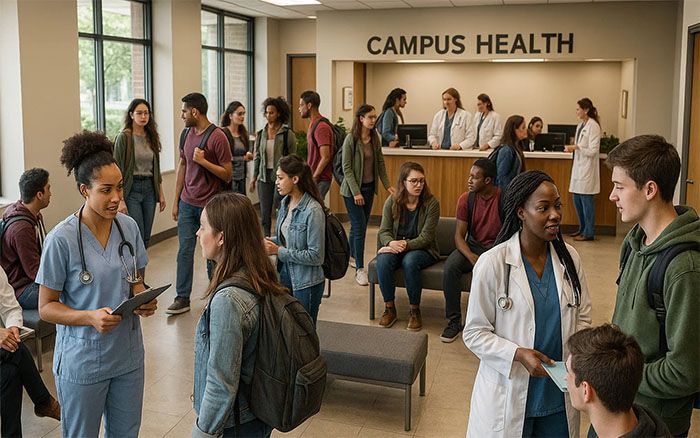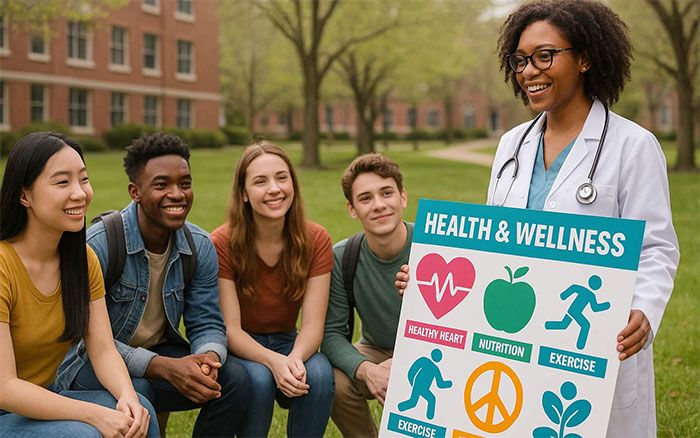Building an Accessible Wellness Culture in Higher Education
According to the CDC, individuals with disabilities tend to rate their health lower compared to those without disabilities, (28.4% versus 61.4%).
This stark disparity underscores the critical need for fostering a culture of inclusive and accessible wellness on campus.
Let’s explore how you can create engaging and accessible wellness programs for your students.
Breaking Down Barriers
Beyond the Physical Accommodations
Going beyond physical accessibility is crucial. For instance, colleges must consider sensory sensitivities, cognitive limitations, and language barriers when designing and implementing programs.
According to Cognitive Disability and Postsecondary Education: A National Study on Earnings, “a student with an intellectual disability who earns a bachelor’s degree may earn 68% more than a student who did not go to college.”
This stresses the importance of offering an environment where students with disabilities can thrive, and fostering an inclusive wellness atmosphere can meaningfully support this goal.
Language Matters
Inclusive communication is key to ensuring all students are aware of the resources available to them.
According to the CDC, health promotion messages frequently neglect accessibility barriers faced by individuals with disabilities.
These barriers include the absence of large-print or Braille materials for those with vision impairments, uncaptioned videos for those with hearing impairments, and complex language that may hinder comprehension for individuals with cognitive impairments.
Ensure your campus utilizes inclusive language with the following strategies:
- Conduct regular accessibility audits of all health-related materials, including websites, social media posts, printed materials, and video content.
- Provide training for staff on inclusive communication and the importance of accessibility.
- Collaborate with disability services to identify and address specific needs within the campus community.
Gain more tips on enhancing health communication here.
Building an Inclusive Culture
Marketing for Everyone
Promote your wellness activities in diverse ways, utilizing channels that reach all student groups.
Consider the following tips:
- Partner with student organizations, utilizing social media platforms, and employing inclusive and inviting visuals in your marketing materials.
- Include individuals with disabilities in posters that are hung around your wellness centers and on your school’s website.
- Ensure that you’re using clear headings and easy-to-read fonts.
- If you’re using any videos to promote wellness and fitness centers on your campus, including captions is also essential.
Creating Safe Spaces
Creating safe spaces for all students is essential for building an inclusive culture.
Foster a welcoming and supportive environment by:
- Establishing clear guidelines against discrimination and harassment
- Promoting respect and understanding
- Actively addressing any concerns raised by students
According to a report from the Center for Collegiate Mental Health at Penn State University, college students experiencing discrimination are more inclined to report elevated levels of social isolation, suicidal thoughts, and overall distress to counselors compared to their counterparts.
This underscores the critical importance of implementing proactive measures to address discrimination and promote inclusivity within the college campus community.
Making Wellness Accessible
Adapting Activities
Making wellness accessible requires a multifaceted approach.
Here’s how to adjust activities so that all students can participate:
- Offer different difficulty levels, providing alternative formats for participation, and incorporate assistive technologies when necessary.
- Ensure wellness areas are physically accessible, with features like ramps,wide doorways, and accessible restrooms.
- Provide quiet spaces for students who require sensory accommodations.
By implementing these strategies, you’ll create a wellness environment where every student feels valued, supported, and empowered to participate.
Utilize Technology
Technology can be a powerful tool for enhancing accessibility.
Online platforms, virtual reality experiences, and assistive applications can broaden participation opportunities for students with various needs.
For example, virtual fitness classes can accommodate students with mobility limitations, while captioning and transcription services can make video content accessible to those with hearing impairments.
Additionally, consider using AI-powered tools to provide personalized wellness recommendations and support.
Embracing technology can elevate your efforts to create more inclusive and engaging wellness programs.
The Power of Partnerships
Collaborating with other campus resources can be invaluable in providing comprehensive wellness support.
Wellness and fitness centers should partner with accessibility services, counseling centers, and student advocacy groups to leverage their expertise and expand their reach.
By working together, these departments can create a more holistic and inclusive wellness experience for all students.
For example, wellness centers can team up with accessibility services to ensure fitness programs are inclusive and adaptive for students with disabilities.
Meanwhile, counseling centers can provide mental health support tailored to students with disabilities, ensuring they receive the comprehensive care they need.
Creating an Integrated Health Strategy
Physical Activity
Early death, dementia, and Alzheimer’s risk can be reduced by up to a 30% among people who regularly exercise.
Some inclusive activities your campus may consider:
- A walking club
- Chair boxing
- Swimming
- Gardening club
- Seated sports
- Rower cycling
- Water aerobics
- Arm bicycling
Adapting physical activities to meet diverse needs requires creativity and flexibility.
With a little innovation, most activities can be modified to accommodate different abilities and preferences.
Whether it’s adjusting intensity, providing alternative equipment, or offering modifications to the environment, inclusive programming ensures that all students can participate!
Nutrition Promotion
Promoting wellness amongst students with disabilities is not limited to physical activity.
Ensuring that students are well-informed about their nutrition and having accessible, nutritious food on campus is also crucial.
Since the gastrointestinal tract is responsible for about 95% of serotonin production, it’s evident that there exists a correlation between food and mental health.
Ensure healthy choices such as fruits and vegetables are placed in high-traffic areas within food halls.
Moreover, limit the amount of processed foods on campus, and ensure that healthy options are as affordable as possible – even lowering costs by 10% could make a positive impact!
Mental Health Support
A recent survey found that 40% of college students considered dropping out in the past six months due to mental health concerns, highlighting the critical need for accessible counseling services.
Colleges can make counseling services more accessible by:
- Providing options such as remote sessions
- Ensuring physical spaces are wheelchair accessible
- Offering materials in various formats to accommodate different disabilities
By incorporating these strategies, you can significantly enhance the overall well-being and academic success of your students.
Measuring Success
By leveraging technology, colleges can track and analyze student engagement in wellness programs more effectively.
This data can reveal valuable insights into which student groups may be underrepresented in these programs, allowing colleges to identify areas for improvement and tailor their approach to better serve specific student populations, including those with disabilities.
Moreover, reporting available through your EHR and other campus systems can facilitate ongoing assessment and adjustment of your wellness initiatives, ensuring that resources are allocated efficiently, and interventions are targeted where they are most needed.
Learn more about the power of reporting here.
Key Takeaways
Making wellness activities inclusive and accessible takes a multi-pronged approach, but the rewards are significant.
By embracing these practices, colleges can ensure every student thrives.
























